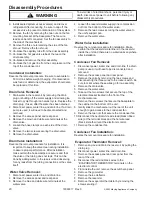
Component Testing
To avoid risk electrical shock, personal injury, or death,
always disconnect electrical power source to the freezer
before attempting to service, unless test procedures require
power to be connected. When removing any wiring from terminals they must be replaced on the same terminals.
Ensure all ground wires are connected before certifying unit as repaired and/or operational.
WARNING
!
10
16022217 Rev. 0
©2003 Maytag Appliances Company
3. If it has been determined that there is proper contact
between the thermistor and the evaporator plate, the
voltage at the thermistor terminals can be read. The
voltage can be read while the unit is running by
attaching test leads to thermistor terminals at the
electronic control. The temperature to switch into the
harvest cycle is 11.0 °F and the corresponding
voltage is 3.0-3.1 V. The temperature to switch into
the production cycle is 45 °F and the corresponding
voltage is 1.9-2.0 V. Slight variations in actual
measurements can occur due to input voltage
variations.
Note:
The temperature and pressure readings must be
taken with unit on and water flowing over the
evaporator plate (in the production cycle). Use
gage pressure readings from the compressors
process tube (low side) access valve.
During production cycle, low side pressures will vary
from 125 psi to 3 psi, depending at what point
measurements are taken. High side pressures can range
from 425 psi to 25 psi also depending at what point
measurements are taken.
In evaluating this system, the best point to determine if
pressures are correct is at the end of the production
cycle. This is the point where there is a thick slab formed
on the evaporator and the evaporator thermostat is near
cut-out temperature.
If low side pressure is below pressure, check for the
following:
1. A system leak
2. Capillary tube is restricted
3. Insufficient compressor
If low side pressure is above pressure, check for the
following:
1. Restricted air flow
2. Dirty condenser coil
3. Leaking or energized hot gas valve
4. Overcharged system
5. Low side leak
Recharging
Recharging of the unit should be done only after
diagnosing and repairing the system (see Sealed
System introduction).
Be sure to flush the system with
dry nitrogen gas and evacuate to 50 microns before re-
charging.
The method for recharging the unit is by weight
using vapor refrigerant
. Using manifold gauge setup,
hook up charge hoses to the access valve on the
compressors process tube. If any access valve was
attached to the high side process tube, remove it and
seal the tube by brazing before charging. Charge the unit
to 5.0 oz (0.313 lbs.) of R-134A.
After recharge, check pressures. Refer to Table A for
corresponding temperatures and pressures. If pressures
or temperatures are incorrect, check the sealed system,
recover the charge, repair, evacuate, and then recharge.
NOTE
: It is not uncommon to have some condensation
or a slight frost on the suction line. This may
occur towards the end of the production cycle.
Liquid refrigerant is not getting into the
compressor if the unit was charged properly. It is
important that the insulation remains on the
suction line and the capillary tube together after
any repair and that it is sealed at both ends.
Hot Gas Valve
The hot gas valve is used to bypass the capillary tube
and send warm gas to the evaporator when opened
during the harvest cycle. The valve is actuated by a
solenoid that opens the valve when energized and closes
when de-energized. The valve seats using gravity so the
valve must remain vertical to fully close.
A faulty hot gas valve will result in long ice production
cycles and higher than normal low side pressures. The
valve usually fails by being stuck in the open or closed
position, or by not fully seating in the closed position
causing the valve to leak-by. A contaminated system or
damage to the valve body will cause any of these
failures. Care in keeping the system clean, handling the
valve, keeping the valve cool during brazing, and
evacuation of the system before charging must be done
to prevent damage and eventual failure of the valve.
A quick way to check the valve to see that it opens and
closes freely (with the system still sealed) is to
repeatedly energize and de-energize the solenoid and
listen for the valve opening and closing. You should be
able to hear a distinct click of the valve opening and
closing. If you can not hear this, then the valve is stuck
and will need to be replaced. The solenoid coil itself can
be check by measuring resistance across the electrical
terminals. A resistance reading of 380-390 ohms should
be found in a good solenoid coil.











































